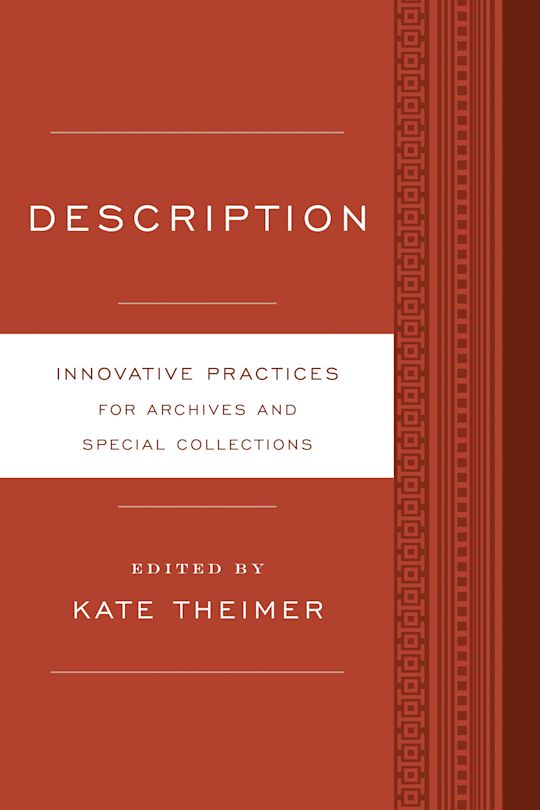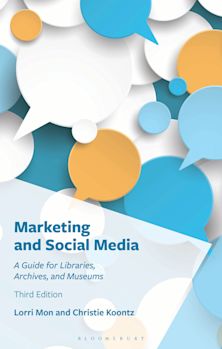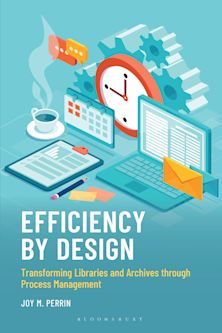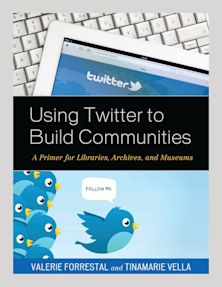Description
Innovative Practices for Archives and Special Collections
Description
Innovative Practices for Archives and Special Collections
You must sign in to add this item to your wishlist. Please sign in or create an account
Description
Description: Innovative Practices for Archives and Special Collections explores how archives of different sizes and types can enhance the accessibility of their holdings. The book uses eleven case studies to demonstrate innovative ideas that could be transferred into many other settings.
Case studies cover
Crowdsourcing the Description of Collections Early Experiences with Implementing EAC-CPFConducting a Comprehensive Survey to Reveal a Hidden Repository Getting a Diverse Backlog of Legacy Finding Aids Online A Collaborative Standards-Based Approach to Creating Item-Level Metadata for Digitized Archival MaterialsCreating Policies and Procedures for Mandatory Arrangement and Description by Records CreatorsCollaboration in Cataloging: Sourcing Knowledge from Near and Far for a Challenging CollectionUsing LibGuides to Rescue Paper Ephemera from the Bibliographic UnderbrushDescribing Records, People, Organizations and Functions: The Empowering the User Project’s Flexible Archival Catalogue Integrating Born-Digital Materials into Regular Workflows Describing Single Items for Discovery and Access
These successful and innovative practices will help archivists and special collections librarians better describe their collections so that they can be successfully accessed and users can locate the right materials.
Readers can use these as models, sources of inspiration, or starting points for new discussions. The volume will be useful to those working in archives and special collections as well as other cultural heritage organizations, and provides ideas ranging from those that require long-term planning and coordination to ones that could be immediately implemented. It also provides students and educators in archives, library, and public history graduate programs a resource for understanding the variety of ways materials are being described in the field today and the kinds of strategies archivists are using to ensure collections can be found by the people who want to use them.
Table of Contents
1) “The Hive”: Crowdsourcing the Description of Collections
Zo? D'Arcy, National Archives of Australia
2) More Than a <biogHist> Note: Early Experiences with Implementing EAC-CPF
Erin Faulder, Veronica Martzahl, and Eliot Wilczek, Tufts University
3) Creating Access and Establishing Control: Conducting a Comprehensive Survey to Reveal a Hidden Repository
Matthew B. Gorham and Chela Scott Weber, Brooklyn Historical Society
4) Step by Step, Stage by Stage: Getting a Diverse Backlog of Legacy Finding Aids Online
Eira Tansey, Tulane University
5) You Got Your Archives in My Cataloging: A Collaborative Standards-Based Approach to Creating Item-Level Metadata for Digitized Archival Materials
Kelcy Shepherd and Kate Gerrity, Amherst College
6) A Long Road: Creating Policies and Procedures for Mandatory Arrangement and Description by Records Creators
Kristjana Kristinsdóttir, National Archives of Iceland
7) Collaboration in Cataloging: Sourcing Knowledge from Near and Far for a Challenging Collection
Evyn Kropf, University of Michigan
8) Where there’s a Will There’s a Way: Using LibGuides to Rescue Paper Ephemera from the Bibliographic Underbrush
Sharon Farnel, Robert Cole, Robert Desmarais, Spencer Holizki, and Jeff Papineau, University of Alberta
9) Describing Records, People, Organizations and Functions: The Empowering the User Project’s Flexible Archival Catalogue
Clare Paterson, University of Glasgow
10) Business as Usual: Integrating Born-Digital Materials into Regular Workflows
Jackie Dean and Meg Tuomala, University of North Carolina at Chapel Hill
11) Opening the Black File Cabinets: Describing Single Items for Discovery and Access
James Gerencser, Dickinson College
About the Editor
Index
Product details
| Published | May 22 2014 |
|---|---|
| Format | Ebook (PDF) |
| Edition | 1st |
| Extent | 1 |
| ISBN | 9798216281320 |
| Imprint | Rowman & Littlefield Publishers |
| Series | Innovative Practices for Archives and Special Collections |
| Publisher | Bloomsbury Publishing |
About the contributors
Reviews
-
Description, one of the titles in the Innovative Practices for Archives and Special Collections series, is a delightful collection of case studies that look at how to increase the accessibility and discoverability of archives. . . .Description is highly recommended for libraries and institutions that have major library and information subject-based collections. The book is also recommended for any information professional who wishes to understand more about archival collections.
Australian Library Journal
-
Editor Kate Theimer has gathered a collection of 11 case studies from institutions around the world describing different methods and experiences in creating better collection descriptions. These topics range from crowdsourcing collection descriptions, utilizing different resources such as LibGuides, collaboration, policy development, and more. Some topics are very in-depth and require significant planning, while others are very direct and could be relatively simple to implement. Each case study follows the same outline and includes sections on planning, implementation, results, lessons learned, and conclusion, while providing additional notes and citations as needed. These case studies are all very well written and do focus on specific and different aspects of this very niche topic. . . . For professionals working in archives and special collections, there is bound to be some helpful information throughout this volume . . . this should prove to be a valuable resource for its targeted audience.
American Reference Books Annual
-
I enjoyed reading this book immensely, and not only because description is the archival function that has always interested me most. All of the case studies are strongly practical, and even pragmatic, describing options and decisions in areas ranging from the technical nitty-gritty, such as the use of particular fields or data elements, to human resources and project management, such as the use of interns and volunteers. A number of the authors write with a dry humour. Many are frank in their assessment of the success of their projects against their initial aims and in how methods and plans needed to be changed in the light of experience. THere is no defensiveness here or institutional 'spin'. Just archivists reporting innovative and practical ways of doing description better.
Archives and Manuscripts: Journal of the Australian Society of Archivists
-
Overall, the case studies chosen are informative and relevant to the archival world today. The most successful ones effectively show how the particular project aimed to build on the repository’s work so far, and critically analyse its benefits and shortcomings. This is altogether a very useful work. The case studies...will help practitioners and students alike to navigate their way around the theory and practice of archival description.
Archives and Records: The Journal of the Archives and Records Association
-
After literally centuries of providing access with flat paper finding aids, the archival community is now grappling with both the heady opportunities and sometimes perplexing challenges of exploring new approaches to description and access in the digital age. Kate Theimer has assembled a virtual laboratory of experiments in access undertaken by colleagues from around the nation and internationally. This collection provides archivists with an important guide to imagining and implementing new ways to more effectively engage users with the rich, essential resources of the archival record. Read it—then join the effort!
Kathleen D. Roe, New York State Archives (retired), Director of Archives and Records Management
-
These thoughtfully selected case studies mine the evolving international, interprofessional, and interactive landscape of archival description in innovative and inspirational ways. The essays comprising this volume take the current temperature of a rapidly morphing profession, and will interest and stimulate a wide array of information practitioners.
Bill Landis, Head of Public Services, Manuscripts & Archives, Yale University Library


































